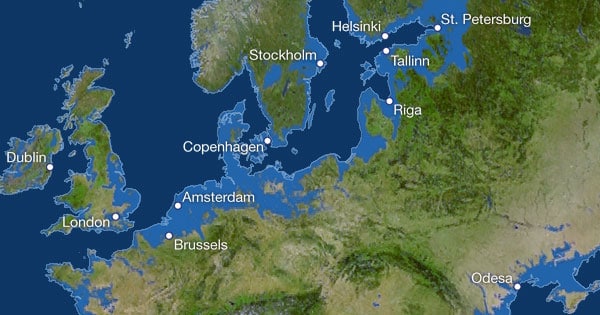Summary in English: A reflection on the problems with creating alt-hist game material relating to World War Two, using the never-completed Swedish RPG Partisan as the basis for the discussion.
Nu har det gått över ett år sedan jag förbluffade Sveriges gamers med nyheten att någon hade givit mig en pärm med den enda överlevande utskriften av det legendariska “förlorade” rollspelet Partisan (länk >>> ). Manuset innehöll bland annat tre väldigt olika Sverige är ockuperat-settingar, men den fjärde som vi hade planerat, den om Tredje Riket (stormakt brun) och andra världskriget, saknades av skäl som jag inte minns.
Mitt tjugosjuåriga jag var entusiastisk inför Partisan, medan mitt nutida sextioåriga jag ser på spelprojektet med mer reserverad blick, särskild på dess tänkta Tredje Riket-scenario.
På 1980-talet låg andra världskriget fyrtio år bort och många av Europas och USAs politiska ledare hade upplevt det personligen som soldater (Helmut Schmidt, George Bush senior), som kollaboratörer (François Mitterrand), som motståndskämpar (François Mitterrand [en kappvändare], Jurij Andropov) eller som civilister (Helmut Kohl, Margaret Thatcher). Flera i min umgängeskrets hade ögonvittnen till kriget omkring sig: min pappas kollega John hade varit flygmekaniker på en svensk B16 Caproni under beredskapen och med nöd och näppe överlevt en störtning, en i gamergänget hade en tysk morfar som slagits på västfronten 1944-45 och blivit fransk krigsfånge, jag hade lärt känna Auschwitzöverlevaren Hédi Fried, och så vidare. Det fanns en närhet till dessa fruktansvärda år, vilket gjorde att de flesta nalkades ämnet med självklar respekt — vi levde bland människor som hade sett hur extraordinärt vidrigt detta krig hade varit.
Den närheten är borta idag. De sista veteranerna är i 90-årsåldern. Band of Brothers, Saving Private Ryan och The Pacific är seriöst menade försök att visa för vårt århundrade hur det var där och då. Men de har tunnelseende — rimligt med tanke på vad en teveserie eller film faktiskt kan omfatta — och gestaltar inte epokens storskaliga massmord, ödeläggelse, skräck och misär.
Hans Alfredson skrev på 1990-talet den alternativhistoriska romanen Attentatet i Pålsjö skog om en tysk ockupation av Sverige. Några försigkomna antinazistiska svenskar genomför på eget bevåg ett dödligt sprängattentat mot ett av de många tysktåg som 1941 for genom Sverige, vilket i sin tur får en rasande Hitler att förklara krig mot Sverige. Alfredsons grepp, en fiktiv självbiografi, fungerar bra, men den är inget källmaterial som jag skulle känna mig bekväm med att använda till ett spel.
Min inställning idag hänger också samman med mina personliga upplevelser av krig, upplevelser som jag delar med tusentals andra svenskar. Under Balkankrigen för 25 år sedan jobbade jag en tid med logistiska spörsmål för våra Blå baskrar i Bosnien (UNPROFOR); jag for aldrig dit ner, men krigets skugga föll över vårt kontor i Södertälje. Samtidigt skrev jag en bok om FN-observatörerna i Kashmir (UNMOGIP). För elva år sedan tjänstgjorde jag sex månader i Kabul som civil specialist i en EU-mission (EUPOL) som sysslade med polisutbildning.
Så utifrån vad mitt sextioåriga jag har sett och hört anser jag att endast några få krig i närtid kan placeras på nästan samma nivå i helvetet som andra världskriget, nämligen Röda Khmerernas massmördarregim i Kambodja på 1970-talet, folkmordet i Rwanda 1994, samt andra Kongokriget kring millennieskiftet (ett sällsynt brutalt krig som krävt miljoner människors liv men som utkämpats i mediaskugga). Retorisk fråga: Skulle de vara lämpliga ämnen för något rollspel? Självklart inte, ty de ligger så nära oss och är så fasansfulla.
Därför är jag idag lättad över att våra försök att skapa Tredje Rikets fiktiva ockupation av Sverige till Partisan har slukats av de elektroniska entropin. Kanske skulle vi ha använt det ockuperade Norge som förebild (jag minns inte), men vårt verk hade ändå endast blivit ett tillrättalagt och nedtonat skrapande på ytan. Wehrmachts vedergällningsmassakrer efter partisandåd (ett antal slumpvis utvalda civilister arkebuseras utan pardon för varje dödad tysk soldat), Gestapos klappjakt och mord på judiska och romska svenskar, de inhemska samarbetsmännens lismande inför den tyske rikskommissariens despotiska styre, eller en svensk motsvarighet till Grini-lägret — hur skulle vi, ett gäng grabbar i tjugoårsåldern, ha kunnat överföra sådana historiska brott mot mänskligheten till en fiktiv situation på ett respektfullt och trovärdigt sätt utan att göra vårt spel ospelbart?








